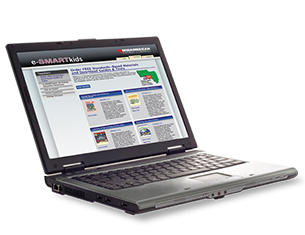| Welcome to MidAmerican Energy Company’s e-SMARTnews! As teachers, you play a critical role in helping students and their families learn to use energy responsibly. Our e-SMARTnews is designed to support you in this effort, providing you with energy education tips that complement the MidAmerican Energy Company’s e-SMARTkids website. We hope that you enjoy this issue and share its energy-efficiency messages and activities with your class and your colleagues. To order FREE materials, view, download or print a variety of educational resources, visit MidAmericanEnergy.com/esmart. |
| Taken together, this newsletter and MidAmerican Energy’s e-SMARTkids website content support Iowa State Standards for Life Sciences (including energy and energy transfer, environmental stewardship and the social and personal implications of environmental issues) and the Illinois Next Generation Science Standards for Physical Sciences and Earth & Human Activity. |
| In This Issue |
|
|
|
|
|
| Household Energy Use Matters! |
| Here in the United States we have an energy-intensive lifestyle. U.S. residents represent about 4% of the earth’s total population, yet we account for 16.5% of worldwide energy use. |
| A great portion of our energy use comes from household energy consumption. The typical U.S. family spends about $1,850 a year on home utility bills, and about half of all energy used in U.S. buildings occurs in homes. It’s clear that by adopting energy-efficient behaviors and technologies at home, we can not only save on our individual energy bills but also significantly reduce the nation’s overall energy consumption. Saving energy means we keep more of the planet’s precious energy resources in the ground as well. |
 |
|
 |
| Energy-Saving Tips for Students |
| The ideas below can help students make energy-saving changes in their daily lives: |
|
| ο |
Bring reusable bags to the store. |
|
| ο |
Buy in bulk (and when you do, reuse your plastic bags). |
|
| ο |
Buy foods grown locally. This saves energy used for transporting food sometimes flown in from the other side of the planet. |
|
| ο |
Reuse containers, bags and other items as much as possible. |
|
|
| |
| • |
| Getting Around |
| Burning fossil fuel to run our cars, trucks, buses, ships, trains and planes generates more greenhouse gas emissions than any other economic sector. This means our transportation choices can have a significant impact on carbon dioxide (CO2) emissions. Encourage students to address this issue by using their legs! It’s a fun and healthy way to save energy. |
| Consider starting a weekly classroom bike-or-walk-to-school day, and see how many students you can enlist to join in the effort. Those students who live too far away to bike or walk to school can participate by walking or biking somewhere each weekend instead of driving. |
|
|
|
| • |
| Line Drying |
| Line drying clothing not only saves energy, it helps clothes last longer! A folding rack in the bathroom, laundry room or basement makes line drying easy in any season. |
|
|
|
| • |
| Reusing and Recycling |
| Familiarize students with the phrase, “Reduce, Reuse, Recycle” as an energy-saving motto! Some ideas: |
|
|
| ο |
Avoid purchasing products like bottled water and disposable cameras. |
|
| ο |
Learn to repair clothes, gadgets and equipment. |
|
| ο |
Borrow books from the library or a friend, or buy them used. |
|
| ο |
Use both sides of sheets of paper. |
|
| ο |
Give away old toys and books instead of discarding them. |
|
| ο |
Participate in clothing swaps or buy clothes at rummage sales or charity shops. |
|
| ο |
Recycle cans, glass and newspaper at home and at school that are labeled with the recycle symbol, a design of three arrows that makes up a circle. This symbol is located on the bottoms of bottles, cans and jars that can be recycled. |
|
| ο |
If your school doesn’t have a recycling program, see if your class can help get one started. |
|
|
 |
|
 |
| Energy-Saving Tips for Families |
| Encourage students to share these Top 10 Energy-Efficiency Tips with the adults in their families: |
| 1. |
HomeCheck® Online – Complete our home energy assessment at MidamericanEnergy.com/homeaudit. Compare your household energy use to that of similar homes in your area, and learn where your home uses the most energy. |
|
| 2. |
Insulate – Make sure your home is adequately insulated in the attic, exterior walls, floors, basement and crawl spaces. In unheated areas, insulate around furnace ducts or boiler pipes. |
|
| 3. |
Lighten Up – Install ENERGY STAR® certified lighting and appliances in your home. ENERGY STAR light bulbs use 75% less energy and last up to 25 times longer than standard incandescent bulbs. |
|
| 4. |
Stop Air Leaks – Use weather stripping and caulk to seal air leaks and block drafts around doors, windows, chimneys, electrical outlets and even in your basement and attic. |
|
| 5. |
Temp Control – Keep your thermostat at 68 degrees or lower in the winter, and 78 degrees or higher in the summer. Install a programmable thermostat to automatically adjust the temperature when you’re asleep or away. |
|
| 6. |
Window Wraps – Put clear plastic sheets over the inside or outside of your windows to reduce heat loss and increase comfort. Kits are available at hardware and home stores. |
|
| 7. |
Open/Shut Them – Keep drapes, shades and blinds open on sunny winter days, especially with windows facing south, and closed on hot and sunny summer days. Closed drapes also double as insulators. |
|
| 8. |
Stop Energy Vampires – When plugged in, many appliances and chargers use electricity even when not in use. This wasted power is called “phantom load.” Save by turning off and unplugging what you can. |
|
| 9. |
Clear the Air – Make sure air registers and radiators aren’t being blocked by furniture, rugs, drapes or other objects. In addition, make sure to regularly dust or vacuum registers or radiators. |
|
| 10. |
Service Your Heating System – Have your heating system serviced yearly so it runs properly and efficiently. Change your furnace filters regularly since dirty filters make the system work harder, and use extra energy. |
|
 |
|
| Activities and Games |
Classroom Activity: Understanding “Payback Periods”
Explain to students that although energy-efficient products can cost more than regular products, they are actually a better investment in the long run because they save money over time. Some energy-efficient products (like LED bulbs) cost more up front than their CFL or incandescent counterparts. But the money saved in energy costs each month will eventually more than make up the difference in the higher purchase price. This concept of a payback period is illustrated in the following activity. |
| Invite a student to draw two imaginary flat-screen televisions on the board, labeling them “TV-A” and “TV-B.” |
| • |
TV-A is an energy-efficient ENERGY STAR TV and costs $379. It uses $10 of energy per month. |
|
| • |
TV-B is a standard TV and costs $319. It uses $20 of energy per month. |
|
| Have students answer these questions: |
| 1. |
How much more does TV-A cost to buy than TV-B? |
|
| 2. |
TV-A can make up for its higher purchase price through money saved on energy bills over a certain period of time, known as a “payback period.” How many months will the payback period last for TV-A? |
|
| 3. |
Why is TV-A the smarter choice in the long run? |
|
| |
 |
| Online Games and Activities |
| Kids can also learn about saving energy through the MidAmerican Energy e-SMARTkids website. This site includes an Ask an Expert feature, where students can submit energy-related questions to our resident expert, as well as a Home Energy Inspection. There is also an Energy Glossary, and games that can be played individually or in a group, in the classroom or at home: |
|

